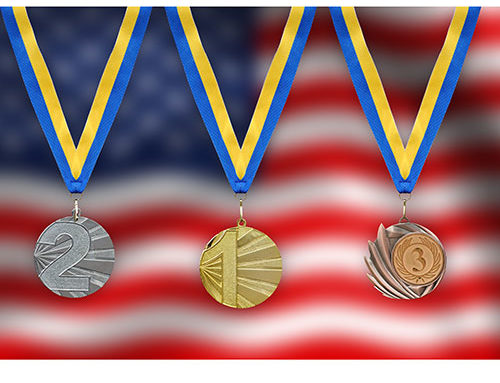Question: What’s more valuable than a 15 on pommel horse?
Answer: A 14.7 in team finals!
The men’s pommel horse has forever been considered by most gymnastics experts to be the most challenging of the men’s six events. Although most casual fans tend to be somewhat fascinated by this unique event, the truth is that the incredible demands this apparatus requires can’t possibly be appreciated until one has actually tried it. “The pig,” as some like to call it, is in a category of its own. It’s the one event among all the men’s and women’s events where – except during crazy wipeouts – there are no flips. It’s the one event that essentially requires constant motion in a horizontal axis – while also opposing gravity in a vertical axis at the same time. And it’s the one event where, if you took a young, healthy, athletic, and ambitious person with no gymnastics experience and asked him or her to try it, that person wouldn’t be able to do a single basic skill. Yep, it’s that difficult.
There’s more than a few great all-around gymnasts who probably wish the event never existed. Jonathan Horton would have only needed a 14.075 on the event to win the all-around SILVER MEDAL at the 2008 Olympic Games…instead his 13.675 landed him in 9th. And at the 2007 world championships the year before, his proud 4th place all-around finish could have easily been a bronze had his lackluster 13.975 on pommels been only two tenths higher. His friend and rival Chris Brooks probably wishes this year’s American Cup had been a five-event competition, since his fall on pommel horse ended up costing him the prestigious title. And 18-year-old sensation Danell Leyva – one of the world’s best on p-bars and high bar – certainly isn’t exempt from the horse’s volatile temperament. His stepdad/coach’s well known explosive cheers tend to be a bit subdued after Danell’s pommel horse routines, as the promising star gets bucked off more often than not. And if Fabian Hambuchen’s pommel horse were even in the same league as most of his other events, world champion Kohei Uchimura might actually have some competition in the all-around.
And then there’s the USA men’s team, which probably had to play a round of “paper-scissors-rock” just before pommel horse – their final event – at the Beijing Olympics to decide which guys were going to step up and try to salvage a team medal . It must have been Raj Bhavsar and Kevin Tan who drew the short straws…their major errors nearly let the bronze slip away before team anchor Alex Artemev delivered the heroic performance we all hoped he was destined for. Even so, had the USA men not had the lowest team pommel horse score of all the eight teams in the finals, its bronze could have easily been silver. And what’s more, it might be the one event keeping the USA from being in striking distance of China.
Since Beijing, we’ve seen a dramatic improvement from team USA on the event…even WITHOUT world medalist Alex Artemev in the mix. We’ve now developed a whole slew of guys who are capable of scoring in the high-14 to low-15 range – a luxury we simply didn’t have throughout the entire last quadrennium. The only problem is that most of these guys are not our top all-around gymnasts, and there’s very limited room for them on a six-member squad…and even less room on the five-member squad we’ll have in 2012.
Below I’ve listed in rank order ALL the USA guys I’ve found who have scored a 14.5 or higher on pommel horse at any major national or international meet in the past year (not counting NCAA meets). For Sho Nakamori, who WILL be competing this week, I used scores from 2008-2009 because he hasn’t competed in the past year since tearing his ACL at the 2009 Japan Cup. The names in bold will all be competing at this week’s Visa U.S. Championships, while the others will not.
| Rank | Gymnast | Best D-Score | Best Final Score |
| 1 | Daniel Ribeiro | 6.8 | 15.9 |
| 2 | Tim McNeill | 6.7 | 15.6 |
| 3 | Luke Stannard | 6.7 | 15.5 |
| 4 | Donothan Bailey | 6.6 | 15.35 |
| 5 | Glenn Ishino | 6.0 | 15.25 |
| 6 | Alex Naddour | 6.3 | 15.15 |
| 7 | Steven Spencer | 5.9 | 15.05 |
| 8 | Chris Cameron | 6.2 | 15.0 |
| 9 | Kyle Bunthuwong | 5.5 | 14.95 |
| 10 | Danell Leyva | 5.9 | 14.75 |
| 11 | Mel Anton Santander | 6.0 | 14.75 |
| 12 | John Orozco | 5.8 | 14.7 |
| 13 | Joey Hagerty | 5.5 | 14.65 |
| 14 | Edward Mesa | 5.9 | 14.65 |
| 15 | Craig Hernandez | 5.8 | 14.65 |
| 16 | Sho Nakamori | 5.7 | 14.6 |
| 17 | Wes Haagensen | 5.9 | 14.55 |
| 18 | Andrew Elkind | 5.6 | 14.55 |
| 19 | Guillermo Alvarez | 5.6 | 14.5 |
I expect these bold names will be the ones to watch out for on pommel horse during this week’s competition…and I do expect that Tim McNeill will still be vying for a spot on the world team, as he is missing this competition due to the recent death of his father. As I implied at the beginning, 15 is the “magic” number on pommel horse, but consistency and reliability are even more magical. We’d take a score in the mid to high-14 range that we know could be delivered under team finals pressure over a 15 that has a high risk of a fall. Any gymnast – whether on this list or not – who scores near or above a 15 both days on pommel horse this week will be in serious contention for the world team.



I did some numerics looking at PH and PH consistency before the 2008 selection. Falls are extremely common. Of the group of 20 or so in consideration only 1 or 2 had no falls out of 4 meets. I think Sasha had 3 (large), but Paul still had like 2 out of 5. (I had included WC for him, since trials was missing).
Also Sasha’s scores even with fall (and Paul also) were still better than Tann.
Also if you want to look at consistency, you can take a few meets and look at average, standard deviation, highest and lowest.
This is a more abstract issue, but it’s not immediately clear that you should take the more consistent gymnast over the less consistent one. If someone averages 15.0 but has a high of 16 and a low of 14, you still miight be better off taking him than someone who gets 14.5 every time up. Only if you are far in the lead, like China, would you want to be conservative and limit your downside.
Actually in some cases, you might even prefer to gamble and take the gymnast with higher upside and LOWER average.
However, to make it simple, I would just take the gymnast with the higher average score. You are going to have 18 routines done. You need to take a statistical view of things and not get out of hands because of the possiblity of a fall. Maximize the likely value.